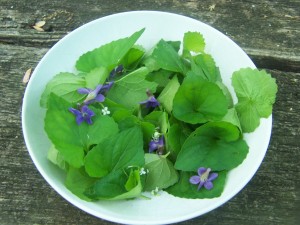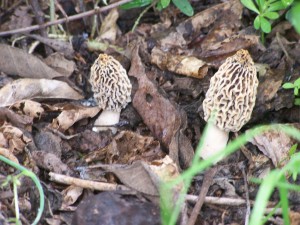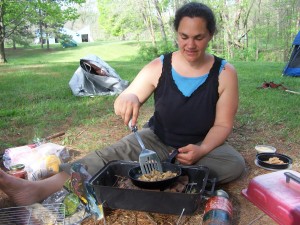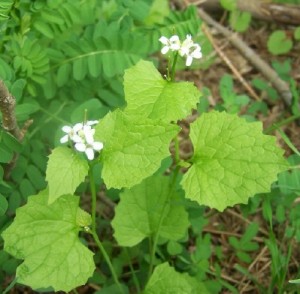There are some things to be aware of: not all parks want you to pick plants, so find out the rules at each park. Some parks do not mind if you pick invasive weeds like garlic mustard, burdock, Japanese Knotweed and will even spray or pull these themselves, so it's worthwhile to ask. We've come across parks where they don't want you to pick any plants (although mushrooms are usually ok), to others who will say weeds such as the ones mentioned above are ok to pick.
We also never pick endangered or protected plants like Trillium, Ferns, or Goldenseal.
When we do harvest plants to eat we only pick what we will eat immediately, so as not to overpick or waste anything. When we are harvesting something like garlic mustard or burdock root from places where they tell you it's ok (sometimes they'll be thrilled!) we sometimes do pick more to dry or use later.
garlic mustard and violet salad
Lately we have found the best wild edibles camping! Chickweed, violets, lambs quarters and garlic mustard make wonderful salads. We usually bring a bottle of salad dressing, but really these wild edibles are so fresh and delicious you could eat them plain! Above you will see one of my favorite simple camping salads for this time of year: garlic mustard green and flowers and violet greens and flowers.
These flavorful edibles also make a good trailside nibble if you get hungry on a hike.
Wild berries will be in season soon...those are always fun to nibble while camping!
wild wineberries
Other wild edibles such as morel mushrooms (below) and other edible mushrooms and nettles are excellent sauteed, and can be eaten over rice or pasta.
morel mushrooms
Burdock roots are excellent cooked into soups or with rice, giving a rich earthy flavor, and the burdock leaf stem is excellent steamed or boiled.
Some wild edibles you can find while camping are great as medicines, too. If you get stung by a bee look for plantain (some call it fairy bandaid) to chew and place on the sting.
If you get stung by nettles, you'll likely find burdock or yellow dock leaves nearby...chew those and apply to the nettle sting.
Poison Ivy? Look for jewelweed, crush and apply this plant to your itchy rash. Plantain will also work to take the itch away.
Wild edibles are full of nutrition and medicinal properties and are excellent to use while camping!
We'll be sure to bring you more camping adventures as the season progresses. Make sure you let us know about your camping wild culinary adventures as well!
Melissa cooking morels over a camp stove
~ Melissa Sokulski










